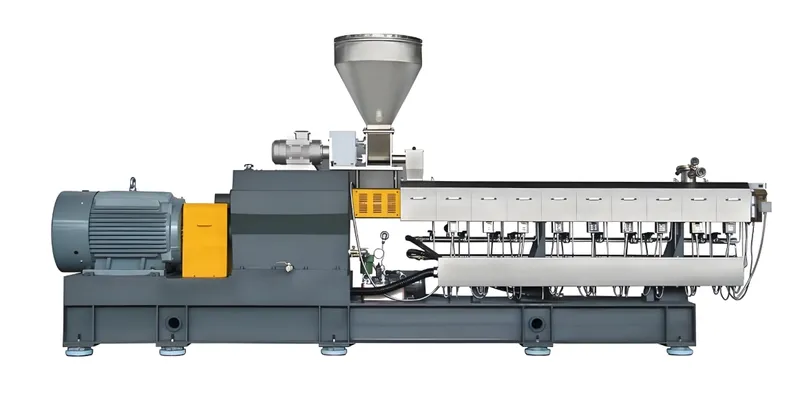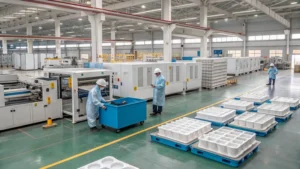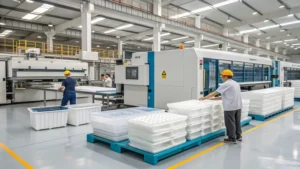
Twin-screw extruders are powerhouse machines that excel in manufacturing processes requiring precision, versatility, and superior mixing. From plastics to pharmaceuticals, these extruders shape industries by transforming raw materials into innovative products. In this blog, we’ll explore the best applications for twin-screw extruders1, breaking down their definition, classifications, technical workflows, and practical tools. Whether you’re in production or just curious, this guide will help you understand where twin-screw extruders shine.
Twin-screw extruders excel in plastics compounding2, food processing, pharmaceuticals, and recycling, offering unmatched mixing efficiency and material control for industries needing precision and versatility.
- 1. What is a Twin-Screw Extruder?
- 2. How Are Twin-Screw Extruders Classified?
- 3. What Are the Best Applications for Twin-Screw Extruders?
- 4. How Do Twin-Screw Extruders Compare to Other Technologies?
- 5. Technical Breakdown: How Do Twin-Screw Extruders Work?
- 6. Practical Tools for Twin-Screw Extruder Success
- 7. Connecting the Dots: Twin-Screw Extruders in the Manufacturing Ecosystem
- 8. Summary Table: Applications at a Glance
- 9. Conclusion
What is a Twin-Screw Extruder?
A twin-screw extruder (TSE) is a manufacturing machine that uses two parallel screws rotating within a heated barrel to process materials. Unlike single-screw extruders, TSEs provide enhanced mixing, melting, and extrusion capabilities, making them ideal for complex formulations.

-
Core Principle: The dual screws convey, mix, and extrude materials with precise control over temperature, pressure, and residence time.
-
Aliases: Commonly called TSEs or "twin-screws" in industry circles.
Twin-screw extruders outperform single-screw extruders in mixing efficiency.True
The dual-screw design ensures uniform material distribution, critical for complex blends.
How Are Twin-Screw Extruders Classified?
Twin-screw extruders come in various configurations tailored to specific needs. Here’s how they’re categorized:
| Classification Type | Categories |
|---|---|
| Screw Configuration | - Parallel: Consistent diameter for uniform processing. |
| - Conical: Tapered screws for specialized pressure or mixing needs. | |
| Rotation | - Co-rotating: Same-direction rotation for optimal mixing. |
| - Counter-rotating: Opposite rotation for enhanced pressure build-up. | |
| Application | - Plastics, Food, Pharmaceuticals, Composites, Recycling |
This variety allows manufacturers to match the extruder to their material and production goals.
What Are the Best Applications for Twin-Screw Extruders?
Twin-screw extruders thrive in scenarios demanding high mixing efficiency3 and material adaptability. Here are their top applications:

Plastics Industry
-
Compounding: Blending polymers with additives (e.g., fillers, stabilizers) for enhanced properties.
-
Masterbatch Production: Creating concentrated color or additive mixtures for plastics.
-
High-Performance Plastics4: Extruding materials like PEEK for aerospace or medical use.

Food Industry
-
Snack and Cereal Processing: Producing textured products like corn curls or breakfast cereals.
-
Pet Food: Ensuring uniform nutrition and texture for kibble.
Pharmaceuticals
-
Drug Delivery Systems: Mixing active ingredients with polymers for controlled-release tablets.
-
Formulation Development: Achieving precise ingredient distribution for new drugs.
Recycling
- Plastic Waste Conversion5: Transforming waste into reusable pellets for sustainability.
Emerging Applications
- Battery Separators: Producing ultra-high-molecular-weight polyethylene (UHMWPE) for electric vehicle batteries.
Twin-screw extruders are limited to plastics processing.False
Beyond plastics, TSEs are vital in food, pharmaceuticals, and recycling, showcasing their versatility.
How Do Twin-Screw Extruders Compare to Other Technologies?
Twin-screw extruders stand out but aren’t always the default choice. Here’s how they stack up against single-screw extruders:
| Aspect | Twin-Screw Extruder6 | Single-Screw Extruder |
|---|---|---|
| Mixing Efficiency | Excellent for complex blends. | Adequate for simple materials. |
| Control | Precise temperature and residence time management. | Less control, suited to basic tasks. |
| Material Versatility | Handles viscous, heat-sensitive, or diverse materials. | Best for uniform, less complex materials. |
| Cost and Complexity | Higher cost and complexity. | Simpler and more affordable. |
| Energy Use | Higher due to dual-screw mechanics. | More energy-efficient for straightforward jobs. |
Takeaway: Choose twin-screw extruders when mixing precision and material flexibility outweigh cost concerns.
Technical Breakdown: How Do Twin-Screw Extruders Work?
Process Workflow
The twin-screw extrusion process follows these steps:

-
Feeding: Raw materials enter via a hopper or side feeders.
-
Conveying: Screws transport the material along the barrel.
-
Melting and Mixing: Heat and shear melt and blend the material.
-
Devolatilization (optional): Vents remove gases or moisture, common in polymer processing.
-
Extrusion: Molten material exits through a die, forming products like pellets or films.
Key Parameters:
-
Screw Speed: Influences mixing and output rate.
-
Barrel Temperature: Controls melting and flow.
-
Feed Rate: Affects consistency and throughput.
Material Compatibility
TSEs handle a broad range of materials:

-
Thermoplastics7: For packaging or profiles; need temperature precision.
-
Elastomers: For seals; require robust mixing.
-
Food Products: Dough or proteins; sensitive to shear and heat.
-
Pharmaceuticals8: Drug-polymer blends; demand uniformity.
-
Composites: Reinforced materials; need even filler distribution.
Twin-screw extruders process all materials identically.False
Each material requires tailored screw designs and conditions for optimal results.
Practical Tools for Twin-Screw Extruder Success
Design Checklist
Before operating a TSE, consider:
- Material Properties: Viscosity and heat sensitivity.

-
Output Goals: Production rate and product specs.
-
Screw Type: Co-rotating for mixing, counter-rotating for pressure.
-
Temperature Settings: Match to material needs.
-
Die Design: Align with desired product shape.
Decision-Making Guide
Use this simple decision tree:
-
Need high mixing efficiency?
-
Yes: Opt for a twin-screw extruder.
-
No: A single-screw extruder may suffice.
-
These tools streamline planning and execution.
Connecting the Dots: Twin-Screw Extruders in the Manufacturing Ecosystem
Twin-screw extruders don’t work in isolation. Here’s their network:

-
Upstream: Material prep (e.g., pre-mixing) and feeding systems.
-
Downstream: Shaping (dies), cooling (water baths), and packaging.
-
Related Tech: Single-screw extruders, batch mixers, injection molding, calenders.
This interconnectedness enhances their role in production lines.
Summary Table: Applications at a Glance
| Industry | Key Applications | Why TSEs Excel |
|---|---|---|
| Plastics | Compounding, masterbatch, high-performance plastics | Superior mixing, uniform additive distribution |
| Food | Snacks, cereals, pet food | Precise control, consistent texture |
| Pharmaceuticals | Drug delivery, formulations | Uniform mixing, heat-sensitive material handling |
| Recycling | Waste to pellets | Versatile material processing, sustainability focus |
| Emerging (e.g., Batteries) | Battery separators | Precision for advanced tech materials |
Conclusion
Twin-screw extruders9 are game-changers for industries needing precision and flexibility. Whether you’re compounding plastics, shaping snacks, formulating drugs, or recycling waste, TSEs deliver results that single-screw alternatives often can’t match. By mastering their applications and technical nuances, you can unlock their full potential in your operations.
-
Explore this link to discover how twin-screw extruders revolutionize various industries with their unique capabilities. ↩
-
Learn about the role of twin-screw extruders in plastics compounding and their impact on product quality. ↩
-
This resource provides insights into optimizing mixing efficiency, crucial for successful manufacturing processes. ↩
-
Learn about high-performance plastics like PEEK and their critical roles in aerospace and medical fields. ↩
-
Discover innovative methods for converting plastic waste into reusable materials, promoting sustainability. ↩
-
Explore the benefits of twin-screw extruders for precise mixing and material versatility in various applications. ↩
-
Learn about thermoplastics to see how they are used in packaging and other applications, enhancing your knowledge of material choices. ↩
-
Discover the role of twin-screw extruders in pharmaceuticals to understand their importance in drug formulation and delivery. ↩
-
Explore the benefits of twin-screw extruders to understand their impact on efficiency and product quality in various industries. ↩








